CDC: With California cluster, 46 new infections, measles cases reach 314
The US Centers for Disease Control and Prevention (CDC) today said measles case counts have reached 314 cases in 15 states—46 more cases than the agency reported in a Mar 18 update. For comparison, the CDC reported 372 cases for all of 2018.
Over the weekend, California confirmed a new cluster of three measles cases in Shasta and Tehama counties. The outbreak is connected to a person who contracted measles during international travel, according to an Action Now local news story.
Arizona, California, Colorado, Connecticut, Georgia, Illinois, Kentucky, Michigan, Missouri, New Hampshire, New Jersey, New York, Oregon, Texas, and Washington have all recorded cases since Jan 1.
So far, the CDC has identified six outbreaks that involve three or more cases, in New York City; Rockland County, New York; Washington state; Texas; Illinois; and California.
Mar 25 CDC update
California Department of Public Health page
Mar 25 Action Now News story
MERS infects 2 more in Saudi Arabia
Saudi Arabia's Ministry of Health (MOH) has reported two more MERS-CoV cases over the past few days, according to epidemiologic week 12 and 13 updates.
One of the MERS-CoV (Middle East respiratory syndrome coronavirus) infections involves a 66-year-old man from Medina who had contact with camels. The other patient is a 61-year-old man from Khames Meshait in southwestern Saudi Arabia who had primary exposure, meaning he likely wasn't exposed to another known patient. A few other cases have recently been reported in Khamis Mushait, including one from earlier this month that involved secondary contact.
The country has now reported 107 cases for 2019, including 57 linked to a large outbreak in Wadi ad-Dawasir in which most cases were linked to healthcare exposure.
Mar 22 MOH report
Mar 25 MOH report
CDC wraps up probe of ground beef Salmonella outbreak
The CDC on Mar 22 posted a final update on a Salmonella Newport outbreak linked to ground beef, which resulted in 403 cases in 30 states. Since the CDC's last report on Dec 12, officials confirmed 70 more cases, along with 2 more affected states.
First reported in October, the outbreak was linked to beef products from JBS Tolleson, Inc., that were produce late last summer and distributed to several retailers, including some large ones such as Winn-Dixie, Walmart, and Sam's Club. The company recalled about 12 million pounds of its non-intact raw beef products.
In its update, the CDC warned that although the outbreak investigation is over, contaminated products could still be in freezers, and it urged consumers not to eat the company's recalled beef, which carries the "EST 267" establishment number.
Of 340 patients with information available, 117 (34%) were hospitalized, and no deaths were reported. The latest illness onset was Feb 8, 2019. Patient ages range from younger than 1 year to 99, with a median age of 42. Forty-nine percent were male.
During the investigation, food surveys found that 86% of the sick patients had eaten ground beef at home the week before they became ill, much higher than the 40% reported in a similar survey of healthy people. Tests by health officials in Arizona and Nevada found the Salmonella Newport outbreak strain in unopened packages of ground beef from retail stores.
Mar 22 CDC final outbreak update
One new polio case in Nigeria, positive case contacts in Nigeria
In its latest weekly update late last week, the Global Polio Eradication Initiative (GPEI) recorded one new case of circulating vaccine-derived polio in Nigeria, the country's second in 2019.
The case of circulating vaccine-derived poliovirus type 2 (cVDPV2) was reported in Kwara state. In 2018, Nigeria saw 34 cases of polio.
"The country continues to be affected by two separate cVDPV2 outbreaks, the first centered in Jigawa State with subsequent spread to other states as well as to neighbouring Republic of Niger, and the second in Sokoto State," the GPEI said. "Recent confirmation of spread of one of the cVDPV2 outbreaks, both within Nigeria and internationally, underscores the urgent need to fill remaining vaccination gaps in the ongoing outbreak response, and to optimize the geographic extent and operational quality of mOPV2 [oral polio vaccine] response."
Last year, Niger experienced an outbreak of 10 cases genetically linked to the outbreak in Jigawa state in Nigeria. While Niger did not record any polio cases in the last week, officials found five cVDPV2-positive samples in healthy community contacts of a case-patient diagnosed in December 2018.
Mar 22 GPEI report










